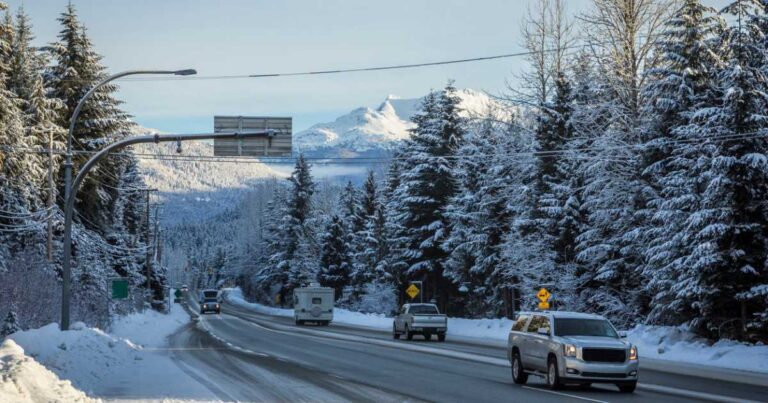As the winter holidays approach, the National Highway Traffic Safety Administration (NHTSA) urges you to stay safe before you head to Grandma’s house— especially in the face of unpredictable winter weather conditions. The colder months often bring snow, sleet, and ice, making driving more challenging and hazardous. In 2021 alone, there were 395 fatal crashes and over 22,000 injury crashes in snowy or sleety conditions. To make sure your winter road trip is a safe one, review these valuable winter driving safety tips from the NHTSA.
Winter Road Trip Safety Tips in Time for Holiday Travel
SafeWise experts have years of firsthand experience testing the products we recommend. Learn how we test and review.
- In 2021, there were 395 fatal crashes on wintry roads.
- 2021 also saw over 22,000 injury crashes in snowy or sleety conditions.
- Use these NHTSA tips to stay safe on the road this holiday season.

Image: VisualCommunications, iStock
Driving in winter weather: The basics
- Slow down: Reduced traction on slippery surfaces means it takes longer to stop. Drive at a safe, controlled speed.
- Increase following distance: Allow extra space between your vehicle and the one in front of you to ensure ample stopping distance.
- Avoid crowding snow plows: Snow plows move slowly, have wide turns, and may frequently exit the road. Maintain a safe distance and exercise caution when passing them.
What to do in an emergency
- Stay with your vehicle: If you're stuck or stranded, remain with your car to stay safe.
- Make sure others can see you: Make your car visible by using bright markers on antennas or windows and keeping the interior dome light on.
- Practice carbon monoxide safety: Ensure your exhaust pipe is snow-free and only run your car sporadically for warmth, with windows cracked open to prevent carbon monoxide buildup.
Tire safety
- Check tire pressure: Make sure your tires are inflated to the manufacturer's recommended pressure (found in the owner's manual or on the driver's side door frame).
- Perform regular inspections: Examine your tires monthly and before long road trips, preferably when they're cold (unused for at least three hours).
- Remember that age matters: Some manufacturers recommend replacing tires every six years, regardless of mileage.
- Look for damage: Inspect for cuts, punctures, bulges, scrapes, cracks, or bumps on the tread and sidewalls.
- Don't forget the spare: Check on your spare tire's condition and replace it if necessary.
Car seat safety in cold weather
- Layer clothing: In colder weather, dress children in thin, warm layers rather than heavy coats before securing them in a car seat.
- Ensure proper installation: Ensure car seats and booster seats are correctly installed, and choose the right seat for your child's age and size.
- Find inspection sites: Use the NHTSA's Child Car Seat Inspection Station Locator to locate a nearby car seat inspection site or get information on virtual inspections.
Batteries and electrical systems
- Battery check: Cold weather reduces battery power. To avoid surprises, have your battery, charging system, belts, and other components inspected by a mechanic.
Electric vehicles: Electric and hybrid-electric vehicles may experience reduced range in winter; keep the battery warm, plug in when possible, and minimize drain.
Safety technologies
- Antilock brake systems: Familiarize yourself with your vehicle's safety technologies, such as antilock brake systems, and use them correctly.
- Driver assistance technologies: Explore driver assistance technologies for added safety during winter road conditions.
Floor mats
- Mat selection: Consider using thicker or rubbery floor mats for winter conditions.
- Proper installation: Follow manufacturer instructions and use retention clips to secure mats.
Preparing your vehicle for winter weather
- Lights: Regularly check headlights, brake lights, turn signals, emergency flashers, and interior lights. Ensure trailer lights are functioning if applicable.
- Windshield wipers: Keep your windshield wiper fluid reservoir full with winter fluid and replace worn blades. Consider heavy-duty winter wipers for snowy areas.
- Cooling system: Verify you have enough coolant and check for leaks. Schedule a tune-up and inspections with a mechanic.
Before you hit the road
- Stock your vehicle: Carry essential winter supplies, including a snow shovel, broom, ice scraper, abrasive material (sand or kitty litter), jumper cables, flashlight, warning devices, blankets, cell phone, charger, water, food, and a roadside emergency kit.
- Gas up or plug in: Keep your gas tank close to full, and for electric vehicles, plug them in to maintain optimal battery temperature.
- Plan your route: Check local weather and traffic reports and plan your route accordingly. Inform others of your itinerary, especially on long trips.
Year-round road safety
- Check for recalls: Use NHTSA's Recalls Look-up Tool or SaferCar app to check for vehicle recalls.
- Avoid risky driving behaviors: Never text or drive distracted, obey speed limits, and always drive sober. Always wear your seat belt for added protection.
By following these winter driving safety tips from the NHTSA, you can help ensure your safety and the safety of others during the holiday season and throughout the winter months. Stay safe on the roads this holiday season, and enjoy a happy and healthy winter.
Related articles on SafeWise
Disclaimer: Portions of this article were assisted by automation technology. All content therein has been augmented, thoroughly edited, and fact-checked by our in-house editorial staff of human safety experts.
Recent Articles



